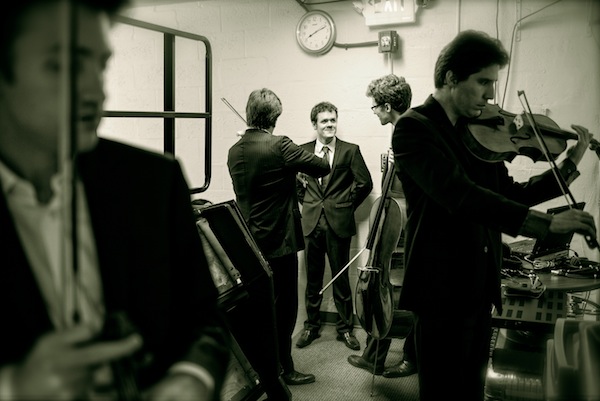
Benjamin Grosvenor + The Escher Quartet = Dynamite
By Sebastian Spreng, Visual Artist and Classical Music Writer
It seldom happens, but when it does, you feel without a doubt that you are witnessing an exceptional event. You get the urge to stop time and call other friends and music lovers to come as soon as possible to share what is essentially incommunicable. If, in addition, the performers happen to be outrageously young, you are also granted a modicum of the hope we sorely need in these times.
Benjamin Grosvenor and members of the Escher String Quartet at UM backstage before the performance. Photo courtesy Peter McGrath
That was the case with the performance of Benjamin Grosvenor and the Escher Quartet at the University of Miami’s Gusman Hall, the last concert of this year’s Friends of Chamber Music series, thanks to an eclectic program that seemed way too short in view of the talent displayed onstage. The members of the Escher Quartet, named after the Dutch artist with whom it may share a thing or two, opened fire with Ainsi la nuit by Henri Dutilleux (1976), a piece you could imagine was slashed into stone with a saber, in a succession of grays. It is a truly nocturnal piece, cold, and terrifying, not recommended listening for someone taking a solitary walk late at night. Those litanies, constellations, reflections of suspended time and space – Escher’s images again come to mind – found in the young Escher musicians thoroughly enthusiastic champions.
With proverbial simplicity and honesty, Benjamin Grosvenor came, played and conquered. A year after his second Miami performance, his talent has further matured, something that at age 21 is also outrageous. His rendition of Mendelssohn, Schubert and Liszt-Gounod pieces simply dazzled, and confirmed his status as a colossus of his generation.
From the first chords of Mendelssohn’s Andante & Rondo Capriccioso, he established the evening’s parameters: elegance, virtuosity and depth, striking luminosity and an unprecedented tonal palette, evident in piece after piece. The Impromptu Opus 90 was an unforgettable hymn to Schubert’s tenderness caught in the magic of incessant movement. Then, when tackling Liszt’s diabolic transcription of the Waltz fromGounod’s Faust, Grosvenor achieved theextraordinary feat of making the sound of both an orchestra and a chorus emanate from a piano. Refinement and clarity are essential traits of this child prodigy turned musical giant.
That same sovereign control, exercised from a distance that never ceases to amaze, marked the second part of the program, which included Dvorak’s famous Quintet for Piano, Opus 81. Here the quartet engaged well with Grosvenor, even though theirs was a different perspective and perception. While not perfect, it was a spirited, stimulating, necessary, provocative exchange, with so many angles it would have delighted Dvorak himself. A remarkable Dane Johansen on the cello and Pierre Lapointe on the viola rounded out the work of violinists Adam Barnett-Hart and Aaron Boyd to deliver a rendition of great beauty, with no dearth of vivid experimentation.
It was a superb finale to the excellent Miami Friends of Chamber Music season. There is nothing left to do but treasure the experience and hope that Grosvenor returns soon, as he has become indispensable.
Recent Content
-
Artsarticle ·
-
Artsarticle ·
-
Artsarticle ·
